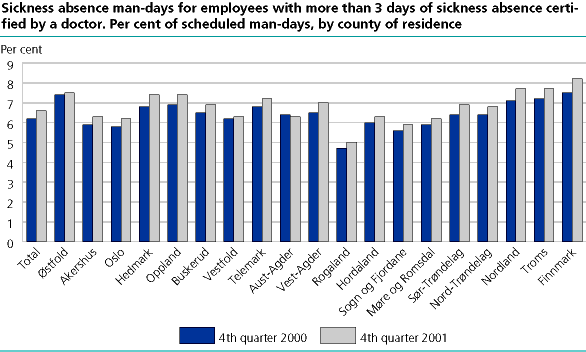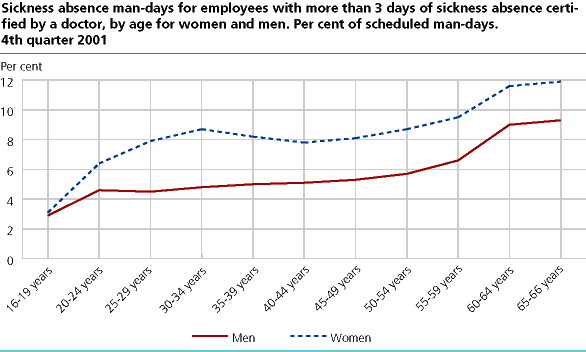Content
Published:
This is an archived release.
Sickness absence increased
The sickness absence rate increased from 6.2 per cent to 6.6 per cent from the fourth quarter of 2000 to the fourth quarter of 2001. The sickness absence increased in all counties except Aust-Agder, where it decreased by 0.1 percentage points. Rogaland had the lowest sickness absence rate with 5.0 per cent. Finnmark had the highest rate, 8.2 per cent.
The sickness absence rate shows the number of man-days lost due to sickness absence as a percentage of all scheduled man-days. This takes into account both position (full-time, part-time) and whether the person is on full or partial sick leave. The statistics include employees with sickness absence of more than 3 days with a doctor's certificate and are produced by Statistics Norway and the National Insurance Administration (RTV).
Decrease in Aust-Agder
Aust-Agder was the only county with a decrease in the sickness absence rate last year. With the decrease from 6.4 to 6.3 per cent Aust-Agder is well below the average rate for Norway of 6.6 per cent. Finnmark had the highest increase (0.7 percentage points) and had still the highest sickness absence rate, 8.2.
Large difference between men and women
By the end of the fourth quarter 2001 the sickness absence rate for women was 8.2 per cent, an increase of 0.4 percentage points from 2000. Men's absence was 5.3 per cent, an increase of 0.3 percentage points.
The difference between men and women is largest in the age groups where women's sickness absence is related to pregnancy, i.e 25-29 and 29-34 years.
Modest increase among elderly
Employees in the age group 50-64 years had a lower growth in the sickness absence rate, 0.2 percentage points than the average (0.4). But still the level of sickness absence increases by age, from around 6 per cent for people in their late 20s to more than 10 per cent for persons over 60 years of age.
Lowest increase in manufacturing
The main industrial groups Manufacturing and mining and Electricity and water supply had the lowest increase in sickness absence from fourth quarter 2000 to fourth quarter 2001 with an increase of 0.1 percentage points. Public administration also had a modest increase, 0.2 percentage points.
Large industries with a considerable increase was land transport (0.8 percentage points) and hotels and restaurants (0.7)
The sickness absence statistics are produced in cooperation with the National Insurance Administration (RTV). The contact person here is Grete Michaelsen, phone (+47) 22 92 72 96.
Tables
The statistics is published with Sickness absence.


